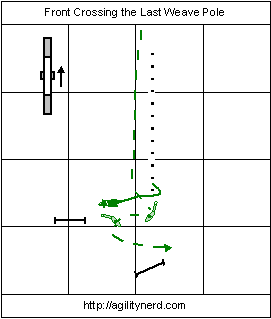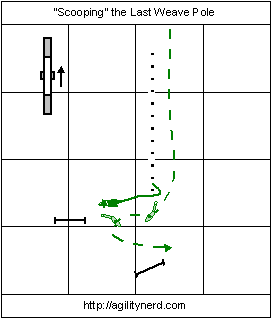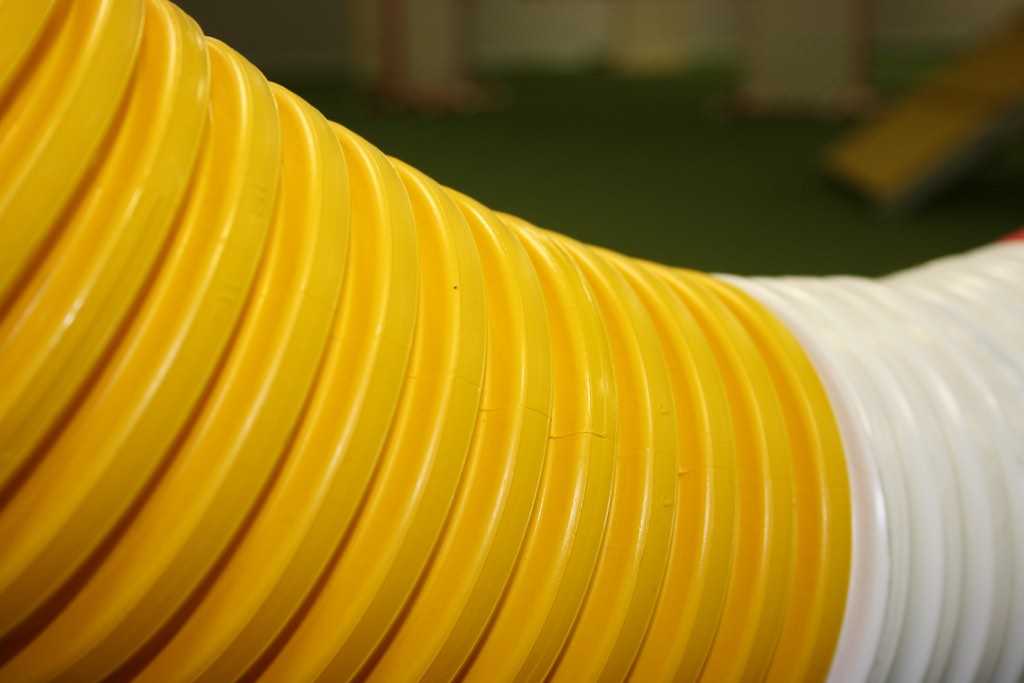Wrapping the Last Weave Pole - With Video
30 Aug 2010
When the dog exits the weaves and the next obstacle is on the same side of the weaves as the entrance the dog needs to wrap around the final pole. The handler can cross at the end of the weaves or Push on the dog’s path to direct them to the next obstacle. This is the corollary to pushing on the last pole. I took a segment from a recent Dana Pike class course, it inspired me to write this article, and turned it into a mini course for demonstrating this skill. This course also lets you work on Off Side weave approaches at speed.
This type of sequence is a challenge for the team without independent weave poles. Rear Crossing Learning the Rear CrossRear Cross the end of the weaves could work for some courses but not for the sharp turn from the weaves to jump 7/12. So that leaves handling solutions where the handler has to get ahead of their dog in the weaves.
Just like any change of direction on course, the handler has to show/cue the way to the next obstacle. The cue needs to come as far ahead of the end of the weaves as possible while not pulling or pushing the dog out of the weaves before completing them. (Sounds like a training opportunity!)
Front Crossing
The Front cross Learning the Front Cross - VideoFront Cross at the end of the weaves is probably the easier approach for most teams:

As long as the handler gets far enough ahead to have their new inside arm (right arm in this example) presented at the last pole before the dog exits they’ll get a tight turn. The less skilled dog can be pulled out of the poles as the handler accelerates into position. But the “beauty” of a front cross is if you are late you can always stand still and wrap the dog around your body to get back on track; it will just be slower.
Pushing Around the Last Pole
The other solution is to not change sides on the dog (keep the dog on the handler’s right in this scenario) and push on the dog’s line by running the outside of the turn:

The handler doesn’t have to be as far ahead as for the front cross, but the handler has to be ahead, there is no “fixing” it (you end up rear crossing). Dana pointed out that this handling is more difficult for the dog because the handler’s motion is opposite the dog’s motion through the last pair of poles (the dog is turning to their left and the handler is moving to the dog’s right) and that requires the dog really understand finishing their weave poles. I also call this a “Scoop”.
Video Demonstration
I took a chance that Meeker’s back felt good enough for a couple runs to demonstrate these handlings. I also drafted Milo to show what could go wrong. Milo will be turning 12 soon and we don’t really do any agility anymore, just a few low obstacles every now and then (you’ll see how his arthritis has effected his jumping) because he loves to play too. He was a good candidate since I knew I could get him to pop out of the weaves if I sped up at the end of the weaves. I sure love him and his enthusiasm (if you look closely in the video you’ll see him hopping around in the foreground while Meeker is running).
If you enjoyed this article won't you please:  Thanks!
Thanks!
Related Articles:
- Turning Dogs out of a Curved Tunnel - Diane Carson's NC Regional Relay Course - With Video
- Dana Pike - Awesome International Sequence - With Video
- Jump Wrap Handling - With Video
- Six Practice Sequences With Video
- Fun Small Space Courses With Handling Options - Annotated Video
- "International" Threadle Sequence - With Video

